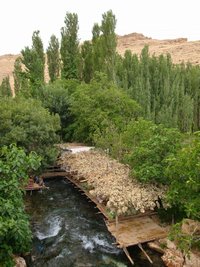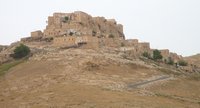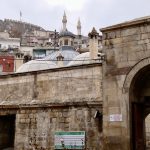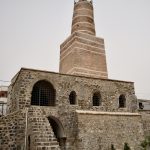Success! On my second try I’d actually managed to get inside the fourth-century monastery of Mor Yakup in Nusaybin. I’d also seen the finished version of the impressive Mesopotamian Cultural Centre (Mitanni Kültür Merkezi). But before heading back to Midyat there were a couple more local attractions that I wanted to tick off.
First stop was to be Mor Augen where the ruins of a fourth-century monastery were scattered across the slopes of İzla Dağı (Mt İzla). It was a site that had been visited by that indomitable British traveller, Gertrude Bell, way back in 1909. More recently it had been visited by the German writer, Hans Hollerweger, whose photographs had inspired me to seek it out. I’d found a taxi driver who knew where the monastery was. The only snag was that the news was making much of an accident in which a local man had stepped on a mine not a million miles away. He had been killed. The driver would take me there, he said, but that didn’t mean that we would necessarily be able to get out and explore.
Fair enough, I thought. At least I would have tested the water for a future visit. As we headed out of Nusaybin the main road swept past the Nezirhan Hotel, bringing back memories of a somewhat absurd night passed there in company with the cast of Sıla and the pop diva Sezen Aksu. We made a quick stop so I could take pictures and check that my memory wasn’t playing tricks in conjuring up a stone-built köşk (pavilion) tucked out of sight behind the hotel’s workaday facade. Then on we sped towards the monastery, pausing in the village of Girmeli to pick up a small boy who would act as our guide.
Girmeli was a pinprick of a place but beyond its boundary even the straggle of houses dropped away and the road began switchblading up into lonely hills. I suppose I was glibly assuming that all would be well and that miraculously I’d be able to visit the monastery, mines or no mines. Then suddenly there were the ruins, way up on the hillside, looking a bit like a more fissiparous version of those at Alahan, near Mut. One look was enough to make it plain that my flimsy summer sandals would not be up to the steep climb along a less than obvious path even without the scare stories.
The driver looked a tad anxious, no doubt expecting me to start pressuring him to take me up there regardless, but this was one of those occasions when it was obvious that I’d have to give in as gracefully as possible. With a look of relief on his face that he tried hard to conceal, he performed a nifty three-point turn on the narrow road. Then as we started back down the hill again to my amazement we saw, racing towards us in a cloud of dust, the same convoy that had been escorting the Mardin Vali on his visit to Mor Yakup except that now the security attachment had been beefed up with a couple of tanks, each with a soldier peeking out of its turret, their guns sweeping a countryside that seemed completely deserted aside from our two groups of monastery-seekers.
I doubt that the Vali got any closer to the ruins than I did – he had been far too smartly dressed for climbing even if no one had bothered him with the bad news. With a chuckle we left them to it and the taxi driver pointed the car north, bearing me on to Kalecik, an extraordinary small village that had cropped up in photographs in the Midyat Cultural Centre. North of Nusaybin a river shadowed the road, its banks buried deep beneath thick stands of trees that splashed verdant greenery into what was otherwise semi-desert. Then suddenly Kalecik loomed up on the left. From a distance it looked completely un-Turkish, as if might somehow have escaped from Tuscany or the south of France. A road zigzagged up to a hill-village that had its back turned defiantly on outsiders, for all the world like a wagon train formed into a circle as protection against the Indians.
As luck would have it summer clouds were forming and as we started to try and find a way to penetrate those defensive-looking walls heavy rain started to fall. According to the information in Midyat the villagers had originally accessed their homes via their roofs just like the inhabitants of prehistoric Çatalhöyük but it looked as if the modern residents were as happy to use normal doors as anyone else. In any case no one was hanging about for me to interrogate them. The village seemed abandoned but for a doleful donkey and a handful of chickens that scattered squawking at my approach.
I longed to linger even with the rain pelting down but the drawback to having to use taxis for research is that you can never linger without racking up preposterous bills. Besides, time was ticking on and I’d set my heart on a trout meal at Beyazsu, the string of ramshackle restaurants lining the river a la Saklıkent Gorge just a few kilometres away. Predictably enough the taxi driver had a venue of choice, presumably owned by a friend of a friend, and it was there that he attempted to park me. One of the very last restaurants, it was nicely sited over rushing water if you could manage to overlook the litter, the cacophonous music and the detritus of downmarket tourism in the form of stalls selling the tackiest of souvenirs. Paying the driver off, I made my escape and wandered back along the road, noting with irritation that one concrete monstrosity had already been allowed to take root amid the simple restaurants on which Beyazsu’s appeal seemed to depend.
Then at last I found what I’d been hoping for – a restaurant far enough from the road to be out of earshot of the traffic, blissfully free of rubbish and with little köşks lined up beside fast-flowing white water. Bliss it was to collapse on the cushions, trail my fingers in the water and watch as large freshwater crabs heaved themselves in and out of it while a fish was gently grilled for me.
There were a final few anxious moments by the roadside while I fretted that the dolmuşes from Nusaybin to Mardin would all be full leaving me as entertainment for the young locals performing wheelies on their mopeds. But of course I needn’t have worried. A dolmuş with an empty seat in it quickly hove into view and that was my “work” finished for the day.


Written: 20 January 2012


